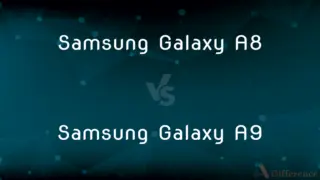Oligosaccharides vs. Polysaccharides — What's the Difference?
Edited by Tayyaba Rehman — By Fiza Rafique — Published on December 28, 2023
Oligosaccharides are short-chain carbohydrates with 2-10 simple sugars, while Polysaccharides are long-chain carbohydrates with more than 10 simple sugars.

Difference Between Oligosaccharides and Polysaccharides
Table of Contents
ADVERTISEMENT
Key Differences
Oligosaccharides are carbohydrates that consist of a small number, typically between two to ten, simple sugars (monosaccharides) linked together. In contrast, Polysaccharides are carbohydrates made up of more than ten monosaccharides and can even extend into the thousands, forming complex structures.
In dietary contexts, Oligosaccharides often serve as prebiotics, promoting the growth of beneficial gut bacteria. On the other hand, Polysaccharides are crucial sources of energy; for instance, starch in plants and glycogen in animals.
Due to their smaller size, Oligosaccharides are typically not digested in the upper gastrointestinal tract and can have unique health benefits, including aiding gut health. Meanwhile, Polysaccharides, due to their larger structures, undergo different digestive processes, with some being digestible for energy and others, like cellulose, being indigestible in humans.
From a functional perspective, Oligosaccharides can be found in various foods and are often added to food products for their beneficial health effects. Polysaccharides, in contrast, play structural roles in plants, like cellulose in cell walls, and storage roles, like starch in potatoes.
Oligosaccharides and Polysaccharides represent different ends of the carbohydrate complexity spectrum. While oligosaccharides contain a limited number of sugar units, making them simpler, polysaccharides are much more complex with extensive sugar units, leading to varied functions and properties.
ADVERTISEMENT
Comparison Chart
Number of Monosaccharides
2-10
More than 10
Digestibility
Often not digested in the upper GI tract
Varies; some are digestible, others are not
Dietary Role
Serve as prebiotics
Provide energy or structural support
Examples
Fructooligosaccharides, galactooligosaccharides
Starch, glycogen, cellulose
Complexity
Simpler, with fewer sugar units
More complex with extensive sugar units
Compare with Definitions
Oligosaccharides
Naturally occurring in various foods like onions and garlic.
Consuming onions provides a source of Oligosaccharides for gut bacteria.
Polysaccharides
Long-chain carbohydrates consisting of more than 10 monosaccharides.
Starch, a common Polysaccharide, is found abundantly in potatoes.
Oligosaccharides
Carbohydrates that often serve as prebiotics in the diet.
Many supplements contain Oligosaccharides to promote beneficial bacteria.
Polysaccharides
Can play structural roles in plants and animals.
Cellulose, a Polysaccharide, provides rigidity to plant cell walls.
Oligosaccharides
Short-chain carbohydrates comprising 2-10 monosaccharides.
Fructooligosaccharides (FOS) are a type of Oligosaccharides beneficial for gut health.
Polysaccharides
Complex carbohydrates that can have varied functional roles.
The Polysaccharide chitin forms the exoskeletons of insects and crustaceans.
Oligosaccharides
Non-digestible sugars that can positively impact gut health.
Foods rich in Oligosaccharides can support a balanced gut microbiome.
Polysaccharides
Essential energy sources in many diets.
Glycogen, a Polysaccharide, stores energy in our muscles and liver.
Oligosaccharides
Added to foods for potential health benefits.
Some infant formulas include Oligosaccharides to mimic human milk composition.
Polysaccharides
Includes both digestible and indigestible types.
While humans digest the Polysaccharide starch for energy, they cannot digest cellulose.
Oligosaccharides
A carbohydrate that consists of a relatively small number of monosaccharides.
Polysaccharides
Any of a class of carbohydrates, such as starch and cellulose, consisting of a number of monosaccharides joined by glycosidic bonds.
Oligosaccharides
Plural of oligosaccharide
Polysaccharides
Plural of polysaccharide
Common Curiosities
Are all Polysaccharides digestible?
No, while some Polysaccharides like starch are digestible, others like cellulose are not.
What's a common dietary source of Polysaccharides?
Starchy foods, like potatoes and grains, are rich in the Polysaccharide starch.
What are Oligosaccharides?
Oligosaccharides are short-chain carbohydrates with 2-10 simple sugars.
Can Oligosaccharides be found in human milk?
Yes, human milk contains specific Oligosaccharides that benefit infant gut health.
Why are Oligosaccharides beneficial for gut health?
Oligosaccharides often serve as prebiotics, promoting the growth of beneficial gut bacteria.
How do Polysaccharides differ from Oligosaccharides?
Polysaccharides are long-chain carbohydrates with more than 10 simple sugars.
How do Polysaccharides function in the human body?
Polysaccharides like glycogen store energy, while others provide dietary fiber.
Are Oligosaccharides naturally occurring?
Yes, they can be found in foods like onions, garlic, and certain beans.
Is chitin a type of Polysaccharide?
Yes, chitin, found in insect exoskeletons, is a Polysaccharide.
What role does the Polysaccharide cellulose play in plants?
Cellulose provides structural support, making up plant cell walls.
What's a primary function of Polysaccharides in plants?
Polysaccharides like starch store energy, while others like cellulose provide structure.
Are Oligosaccharides considered complex carbohydrates?
While they are more complex than monosaccharides, they're simpler than Polysaccharides.
How do Oligosaccharides affect the gut microbiome?
Oligosaccharides promote the growth of beneficial bacteria, positively impacting the gut microbiome.
Why might manufacturers add Oligosaccharides to food products?
Oligosaccharides can be added for their health benefits or to improve texture and taste.
What Polysaccharide is essential for energy storage in animals?
Glycogen, stored in muscles and liver, is the primary energy storage Polysaccharide in animals.
Share Your Discovery

Previous Comparison
Angular Velocity vs. Tangential Velocity
Next Comparison
Samsung Galaxy A8 vs. Samsung Galaxy A9Author Spotlight
Written by
Fiza RafiqueFiza Rafique is a skilled content writer at AskDifference.com, where she meticulously refines and enhances written pieces. Drawing from her vast editorial expertise, Fiza ensures clarity, accuracy, and precision in every article. Passionate about language, she continually seeks to elevate the quality of content for readers worldwide.
Edited by
Tayyaba RehmanTayyaba Rehman is a distinguished writer, currently serving as a primary contributor to askdifference.com. As a researcher in semantics and etymology, Tayyaba's passion for the complexity of languages and their distinctions has found a perfect home on the platform. Tayyaba delves into the intricacies of language, distinguishing between commonly confused words and phrases, thereby providing clarity for readers worldwide.













































